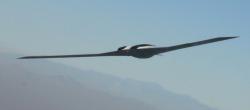Fire and Forget -- Automating the Construction of Our Automated Weapons
 *
*Skunk Works photograph
New Scientist reports on Lockheed Martin's unmanned aircraft, the Polecat, which is partially manufactured from "printed" parts. The article notes:
...the Polecat unmanned aerial vehicle (UAV) is a 28-metre flying wing, weighing four tonnes. It was designed in part to test cheaper manufacturing technologies.
...And since UAVs tend to crash more often than piloted planes, the race is on among UAV makers to make them cheaper. The Skunk Works thinks a technique called 3D rapid prototyping, or "3D printing", is the best way to lower costs.
...In rapid prototyping, a three-dimensional design for a part - a wing strut, say - is fed from a computer-aided design (CAD) system to a microwave-oven-sized chamber dubbed a 3D printer. Inside the chamber, a computer steers two finely focused, powerful laser beams at a polymer or metal powder, sintering it and fusing it layer by layer to form complex, solid 3D shapes.
The technique is widely used in industry to make prototype parts - to see if, for instance, they are the right shape and thickness for the job in hand. Now the strength of parts printed this way has improved so much that they can be used as working components.
Reportedly 90% of the Polecat was made from composite materials, many of them shaped by rapid prototyping. Frank Mauro, director of UAV systems at the Skunk Works, says the entire Polecat airframe was constructed using low-cost rapid prototyping methods and materials, resulting in order of magnitude reductions in fabrication and assembly time.
This kind of step forward in manufacturing has many implications, both good and bad. First, as Jamais Cascio has pointed out, we're already moving into an era in which paramilitary groups, terrorist organizations and petty warlords will be able to manufacture their own advanced weapons from "tabletop" manufacturing systems. But the fact that rapid prototyping has advanced to the point that we can now make part of an airframe -- a structure that has to endure serious stresses in its routine use -- out of these composites, then the scope of what can be built by cutting-edge desktop factories has obviously outpaced the expectations of all but their wildest enthusiasts.
What does that mean for the rest of us? On the one hand, even more advanced weapons could end up in the hands of the world's very worst people. On the other, those of us who have access to such technologies in the advanced world will soon be in a position to manufacture more and more complex products and equipment, thus reducing our dependence on global supply chains and enabling innovative people and companies to turn inventions and refinements into reality with a simple change of the digital plans in our Fab Labs and RepRaps. (Slang for replicating rapid prototyping machines.)
From a civilian point of view, on the one hand you have a technology custom made for the inspired inventor and the innovative company. On the other, this puts resources in the hands of small groups that could be used to dramatically develop areas in the third world which are normally cut off from our global industrial base... and which could also be used to rebuild areas temporarily or permanently cut off from outside help due to a disaster. (For example, those towns and rural areas in the U.S. lacking in power for months after Hurricane Katrina.)

0 Comments:
Post a Comment
<< Home